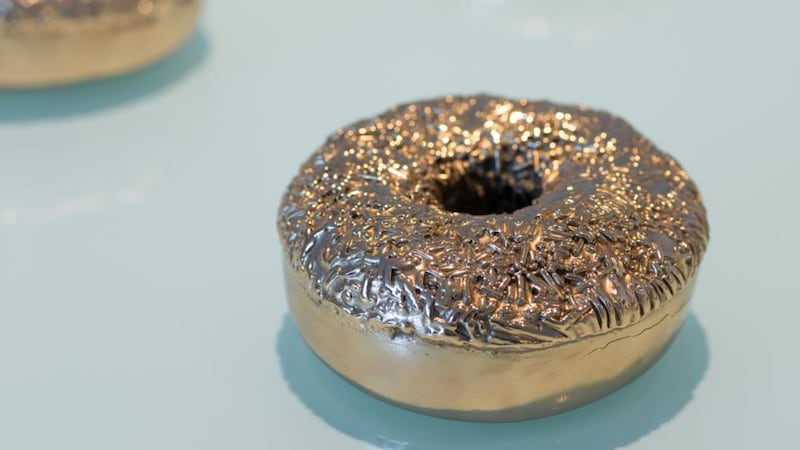The Norwegian artist Magnhild Opdøl came to Ireland to study at NCAD in Dublin in 2004, and she's been based in Ireland since. She has exhibited widely here, as well as showing abroad. Her forensically precise drawings of animals – often dead, sometimes half-consumed or decaying – are chillingly beautiful, as are her sculptural objects, including taxidermy sculptures. She also makes hauntingly effective use of photography and video.
Two factors in Opdøl's background have contributed significantly to shaping her vision. The first is that she comes from a farm and, as she has observed, you soon become familiar with cruelty and death if you live in a rural setting. Not because the cruelty is imposed, but because it's built into the natural world. The second is that her local village, Sunndalsøra, was twinned with Issaquah city in Washington state, in the King County region where Mark Frost and David Lynch filmed the cult television series Twin Peaks.
Attuned to Twin Peaks
Something about the mood and iconographic style of that show chimed with her approach to art. She is drawn to a similar combination of surreal, quirky humour and the macabre. Both are fully in evidence in her Butler Gallery show, Point of no return, which is arranged in a sequence of four interlinked but essentially self- contained installations, with an introductory taster at reception. Apart from anything else, it's a very good piece of design.

From the beginning, Opdøl has been intrigued by the human propensity to sentimentalise nature. We build barriers in our mind permitting us to ignore harsh realities and to focus on comforting myths. Our pets are cute killers. Equally cute lambs are bred for slaughter and consumption. Nature is red in tooth and claw, and we are in the thick of it.
Her objective is not to moralise. She once made a series of drawings called Smiles. Each depicts only an animal mouth, carnivorous teeth bared. Death underlies vitality.
In We're afraid to go home in the dark and Fear of the unknown, which occupy the first room in the Butler, she has taken dozens of vintage postcards of deer in sylvan settings and blacked out the backgrounds, turning day into night and changing the mood of the images from benign to ominous. Deer are, for Opdøl, an equivalent of Laura Palmer in Twin Peaks, a sacrificial victim whose death triggers the realisation that things are rotten beneath the civilised veneer. In the gallery, a tiny, polished bronze sculpture based on Bambi is juxtaposed with this wall of endless, encroaching darkness.
Two rooms on, in Mysteries of Love, a pair of taxidermy roe deer forelegs are used to form a gun holder. Opdøl didn't invent this: such holders are not uncommon. Her holder cradles not a rifle but a trimmed length of tree branch, a reference to the "log lady" in Twin Peaks and, perhaps, to Pinocchio, the wooden puppet who dreams of becoming a real live boy.
Another polished bronze, Being in Darkness, of an untidily extinguished candle, also refers to the Pinocchio story, while an adjacent drawing, Three days later, depicts two spent matches.
The scene of death
Opdøl, with her forensic instincts, often concentrates on aftermaths: the scene of death, the body decomposing or consumed. Overall, in Point of no return she's aiming for something slightly different, for the moment when the line is crossed and there's no going back. The show's title work is a photograph of an abandoned rural dwelling that is slowly imploding as it decays.
The other dominant motif suggests that she has in mind a endlessly destructive process of greed and consumption. It's also adapted from Twin Peaks: the doughnut. Invitation to Love is a monumental stack of 299 pink doughnut boxes. The abstract form, composed of objects with a consumerist, edible association, recalls the work of artists such as Janine Antoni, who set about deconstructing monolithic – and pretty much exclusively male – minimalist sculpture by introducing bodily experience into the idiom.
Opdøl’s doughnut boxes make an extremely flimsy monument, but move on to the next room and their contents, the doughnuts, are given durable, reverential substance by being cast in bronze. There is still the ambiguous flirtation with abstract form but the implication is that a culture dependent on exponential consumerist growth is, to paraphrase Theodor Adorno’s paraphrase of Brecht, a mansion built on dog shit – a phrase peculiarly apposite to Opdøl’s matter-of-fact approach.
Point of no return: drawing, sculpture and installation works by Magnhild Opdøl is at the Butler Gallery, Kilkenny Castle until July 28













